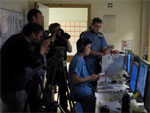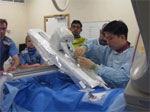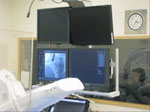First human use of Catheter Robotics' "Amigo" at Leicester
11 May 2010
 |
| Dr Ng controlling the Amigo from a room adjacent to the theatre |
A pioneering world first robotics system operation was conducted at Glenfield Hospital Leicester last month, thanks to expertise at the University of Leicester and University Hospitals of Leicester. Manufactured by Catheter Robotics Inc in the US, Macclesfield-based Dot Medical Ltd. has been appointed distributor and clinical support for the Robot in the UK and in Europe.
Dr André Ng, senior lecturer in cardiovascular sciences at the University of Leicester and consultant cardiologist and electrophysiologist, GlenfieldHospital, UniversityHospitals of
 |
| Dr Ng preparing the |
He used the Catheter Robotics Remote Catheter Manipulation System, named the Amigo, for the first time in a heart rhythm treatment procedure. The system is novel because it allows a doctor to carry out a common heart treatment procedure remotely using a robotic arm.
 |
| Operating the robot from behind the safety of the |
Dr Ng said, "The new Robotic procedure is an important step forward because, while some procedures are straightforward, others can take several hours. Because X-rays are used to allow the doctor to monitor what is going on inside the patient, it means that doctors standing close to the patient wear radiation shields such as lead aprons which are burdensome. Protracted procedures can lead to clinician fatigue and high cumulative radiation exposure."
"The benefit of the Robotics system to the patient is that movement of the catheter can be done with great precision. It is anticipated that further developments of the system may allow complex procedures to be made more streamlined. On the other hand, benefits to the doctor are that heavy lead aprons would not be necessary as they will be controlling the movements of the catheter using the remote controller at a distance from the patient outside the radiation area. They can also be sitting closer to the monitors displaying electrical signals and x-ray images as opposed to standing at some distance across the room from them which is current practice."
Dr Ng and his team's international standing and leading position in the management of heart rhythm disorders are reflected in the invitation to be the first to apply this new robotics system in clinical procedures which also affirms the world-class research and pioneering work at the University of Leicester.
Dr. Ian Rankin, managing director of Dot Medical, said, "We are delighted to have been directly involved with the Worlds first use of the Robotic Arm and in supporting Dr. Ng in its use. The Robot allows the Cardiologist to work in a much safer environment, away from harmful radiation and increase the precision of these heart operations. We believe that the Robot offers a major step towards health and safety in the cardiac catheter lab."






























